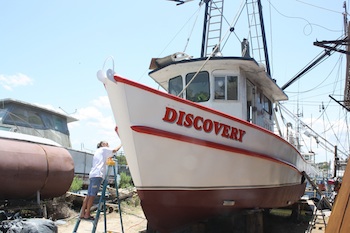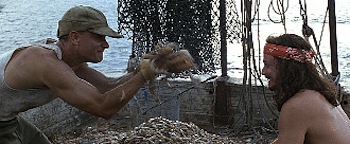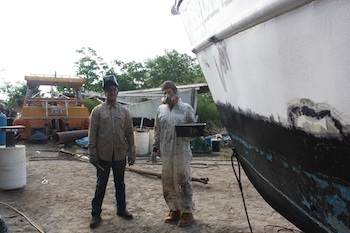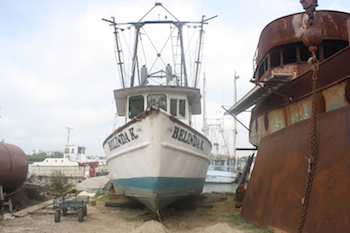Forrest Gump was one of those rare films that changed the way people think about random everyday stuff, from a box of chocolates to a new pair of sneakers to the way one pronounces the name Jenny. For me, the film comes to mind when- or wherever there are shrimp. In one of the film’s most memorable scenes, Forrest and Lieutenant Dan, following many failed attempts at shrimping and a nearly fatal hurricane, finally get their first big catch. C-shaped crustaceans wriggling on their once barren boat deck are at that point more than just food: they symbolize an entire narrative of loss and perseverance. Just imagine if Forrest and Lieutenant Dan had been artists.
Eric Leshinsky and Zach Moser, artists in residence at the University of Houston’s Cynthia Woods Mitchell Center for the Arts, have dedicated three years of their practice to working as shrimpers in Galveston Bay, the second largest seafood-producing bay in the nation (after the Chesapeake). Shrimp Boat Projects was conceived five years ago, following hurricanes Katrina and Rita. “After those hurricanes, shrimp boats were still an iconic symbol of the Gulf Coast, but a lot of them were idle, washed up onto the shore, or out of commission,” says Leshinsky. “Looking for ways of regenerating those boats or activating that symbol was a starting point [for us].” Moser adds that they we’re also “growing tired of the Gulf Coast only being able to define itself within the spectrum of disaster.” In looking for “a productive way” of talking about the area, the artists came to shrimping—a complex regional industry that functions at the intersection of ecology, economy, commerce, and culture.
Leshinsky and Moser are taking their work seriously, laboring almost as if their livelihoods depend on it. “It’s a goal of ours to be committed to learning the profession well enough so that what comes from it is as relevant to as many shrimpers as possible. A big part of that is paying the dues of working on the boat.” The guys recently Skyped with me from the boatyard where they have been working for the past four months, roughly twelve hours a day in relentless Texas heat, rehabbing their salvaged vessel, The Belinda K. This part of their ride has already been choppy: their boat was scheduled to launch with the beginning of the Texas Bay shrimping season in late spring, but necessary boat repairs have put them months behind schedule. In about a week, The Belinda K. will finally return to the water with Leshinsky and Moser as her deckhands. Their captains, a few hired local experts, will take turns on the boat, teaching the artists how to shrimp in their first year. “We’re going to try and go out as much as possible,” says Leshinsky. “We’re humbled by how much we need to learn.”

Shrimp Boat Projects, The Belinda K. (after), newly named “Discovery.” Lettering by Cathy Blume, “the premier shrimp boat painter on the Texas coast.” Courtesy the artists.
Shrimping as represented in Forrest Gump is intentionally hokey and tells us little to nothing of the actual business or culture. Leshinsky and Moser have set out to understand it and the Galveston Bay region at large in all its particularities and multiplicity. One of their tactics is an Artist Exchange program. Their crew this season will include artists, writers, ecologists, and people from other disciplines who responded to an open call to join Leshinsky and Moser on their expeditions. “We’re trying to help people have a fuller understanding of the people who are living and working here, and access to a more holistic picture of the culture and the contradictions that we feel defines this place,” says Moser. “A lot of times people come and do work about this area and too easily step on one side or the other of pretty complicated issues. The experience of this region might be more accessible from a shrimp boat than other ways. Well, this our the hypothesis and we’re just getting started on testing the theory.”
Shrimp Projects is designed to occur in three phases: research and shrimping, shrimping and dissemination, and then production of new artwork based on their experiences. (University courses, public events, an exhibition and publication, and a public forum are all part of the plan.) Though still in phase one, before long, Moser and Leshinsky will start selling their catch, becoming active players in the regional economy. Their current bait license allows them to catch up to 200 pounds of shrimp every day of the year. “The loose plan is to take [the shrimp] up into Houston and as part of the research phase, do different marketing experiments, and see what we can do with them, says Moser. “We’re hoping to market it as a fresh caught local product.” The fresh-local spin seems an easy sell if you live in a gastronomic destination like New York City or San Francisco, where farmers markets, community supported agriculture groups, and other locavore options are booming. But not every part of the country is on that boat. “All of the money in shrimping right now is in selling live bait,” explains Moser. “That’s basically selling it to recreational fishermen who go out to the Bay and kind of throw it back in. And then there’s no money left in food shrimp. The market is set up here so that local shrimp are just commodified and indistinguishable from farm raised imported shrimp. Basically, all of the shrimp that’s [caught] here is shipped to Mississippi to be peeled, frozen and bagged.”

The shrimp boat fleet at Hillman’s Seafood on Dickinson Bayou, the largest concentration of active shrimp boats working Galveston Bay. Courtesy the artists.
Leshinsky and Moser have learned a lot about the shrimping industry these past six months, if not through their labor than through conversations. Simply “talking to everyone” is among their research methodologies. From environmental activists to academics to restaurateurs, they have been engaged in discussions with people whose work is connected to the Bay. At the boatyard, they have formed relationships with shrimpers and shrimping families, some of whom are more enthusiastic about their project than others. I suspect that the artists have social challenges ahead of them. But as shrimping becomes second nature, maybe the community will start to feel like a second family. “If there’s been a pattern, the more time we invest in this place, the better relationships end up going with some of the people we meet,” says Leshinsky. By being artists-in-residence at the Mitchell Center, we’ve been given quite a bit of flexibility to dig into this place and really spend a lot of time here. That makes the project somewhat unique.”
Read more about Shrimp Boat Projects’ Regional Artist Exchange here. On a separate note, Nicole will be eating her way through Woodstock next month. Artist Leah Rosenberg, creator of art-inspired desserts for Blue Bottle Coffee Company/the San Francisco Museum of Modern Art’s Rooftop Cafe, will be guest blogging for Gastro-Vision.







Pingback: Resources » Gastro-Vision